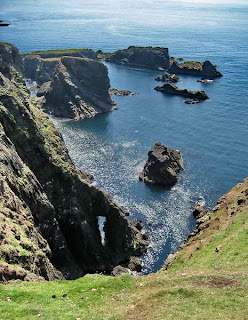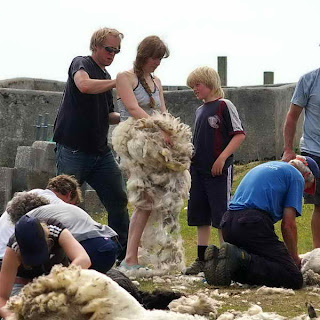Fair Isle is among other things famous for birds of various kinds, stationary as well as migrating. For this reason there is a famous bird observatory which also works as a hostel. This year however it was closed as they were currently building a new but they were still lacking funds so we will have to sea what the future will bring.
Fair Isle has a population of about 70 people living in traditional crofts on the fertile south side of the island and sheep, cattle and ponies are grazing on the rocky moorland. In the past the islanders were also trading with passing ships. In particular warm knitwear suitable for the arctic trade routes was popular items produced on the island and still is today.
Human settlements dating back 5000 years have been excavated and there are traces of oval shaped stone houses maybe as old as 3000 years. Today the Fair Isle people are self sufficient and far away from any mainland power grid they are producing their own electricity. Previously by a diesel driven generator but today 80% of the power is produced by wind turbines. Fair Isle is definitely worth a visit and the harbor is sheltered for normal summer winds but exposed to the north. However the weather can shift with little notice so be well prepared. At times not even the ferry boat the Good Shepard IV can maintain it’s 3 times a week itinerary from Shetland and people can be stranded on one either side of the route.
Our journey from Lerwick to Fairs Isle was particularly exiting as we sighted a pod of Killer Wales (also called or Orcas) for the first time. The pod came very close and one even came to visit us with a dive under the boat. Pleas se the pictures below. Click on the picture to enlarge.
 Killer Whales or Orcas, sighted south of the island Mousa on our way to Fairs Isle.
Killer Whales or Orcas, sighted south of the island Mousa on our way to Fairs Isle.
 A male Orca with its distinctive fin.
A male Orca with its distinctive fin.
 "Look, see what I can do!"
"Look, see what I can do!" Fair Isle is spoted in the south after a short odd rain shower. The distinctive Sheep rock is seen on the far left, showing the way to the harbour.
Fair Isle is spoted in the south after a short odd rain shower. The distinctive Sheep rock is seen on the far left, showing the way to the harbour. An old one cylinder engine spoted on the beach. I wonder how many hours it would take to get it running again.
An old one cylinder engine spoted on the beach. I wonder how many hours it would take to get it running again.

 One of the two churches on the island. The is one Scottish (state) church and one Methodist church. Service in each churche is held on alternating Sundays.
One of the two churches on the island. The is one Scottish (state) church and one Methodist church. Service in each churche is held on alternating Sundays.  The light house on the south side. It was severly damaged by German bombs during the 2nd world war and two lighthouse keepers wifes were killed but the lighouse was restored and back in service again, important as it was.
The light house on the south side. It was severly damaged by German bombs during the 2nd world war and two lighthouse keepers wifes were killed but the lighouse was restored and back in service again, important as it was. 
























No comments:
Post a Comment